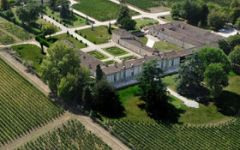Chateau Magrez Fombrauge Blanc 2018
-
Robert
Parker -
James
Suckling -
Jeb
Dunnuck



Product Details
Your Rating
Somm Note
Winemaker Notes
Professional Ratings
-
Robert Parker's Wine Advocate
The 2018 Magrez Fombrauge Blanc is a little subdued on first sniff, opening out to apple tart, ripe pears and nectarine notions plus wafts of coriander seed and waxed lemons. Medium-bodied, the palate has bags of zippy stone fruit and apple layers with a spicy undercurrent and long, refreshing finish.
Barrel Sample: 91-93 -
James Suckling
Green apple, lemon zest, lime blossom and a touch of honey on the nose. It’s medium-bodied with bright, tangy acidity. Layered with delicate precision and a tight, mineral finish. Drink or hold.
-
Jeb Dunnuck
Lots of pretty pineapple, honeyed lemon, subtle almond, and white flower notes all emerge from the 2018 Château Magrez Fombrauge Blanc. Medium-bodied, it has a pure, balanced texture, moderate acidity, and a solid sense of minerality on the finish. This is a solid, impeccably made white that's going to shine for 4-5 years.
Other Vintages
2020-
James
Suckling
-
James
Suckling -
Wine
Enthusiast -
Wine
Spectator -
Robert
Parker -
Jeb
Dunnuck
-
James
Suckling -
Robert
Parker


The plot-by-plot selection, the age of the vines, the specific orientation of the vine rows, the proportions of grape varieties used and the control over vigor of the vines all give this cuvee its special quality. The grapes are hand-picked. A team of 80 people de-stem them, again by hand, one by one.
As production is intentionally very low, vinification is conducted in small vats. All winery operations are performed using the gravity feed technique.

Sometimes light and crisp, other times rich and creamy, Bordeaux White Blends typically consist of Sauvignon Blanc and Semillon. Often, a small amount of Muscadelle or Sauvignon Gris is included for added intrigue. Popularized in Bordeaux, the blend is often mimicked throughout the New World. Somm Secret—Sauternes and Barsac are usually reserved for dessert, but they can be served before, during or after a meal. Try these sweet wines as an aperitif with jamón ibérico, oysters with a spicy mignonette or during dinner alongside hearty Alsatian sausage.

One of the most important wine regions of the world, Bordeaux is a powerhouse producer of wines of all colors, sweetness levels, and price points. Separated from the Atlantic Ocean by a coastal pine forest, this relatively flat region has a mild maritime climate, marked by cool wet winters and warm summers. Annual weather differences create significant vintage variations, making Bordeaux an exciting French wine region to follow.
The Gironde estuary, a defining feature of Bordeaux, separates most of the region into the Left Bank and the Right Bank. Farther inland, where the Gironde splits into the Garonne and Dordogne Rivers, the bucolic, rolling hills of the area in between, called Entre-Deux-Mers, is a source of great quality, approachable reds and whites.
The Left Bank, dominated by Cabernet Sauvignon, contains the Médoc, Graves, and Sauternes, as well as the region’s most famous chateaux. Merlot is important here as the perfect blending grape for Cabernet Sauvignon adding plush fruit and softening Cabernet's sometimes hefty tannins. Cabernet Franc, Petit Verdot and Malbec may also be used in the Left Bank Bordeaux wine blends.
Merlot is the principal Bordeaux wine variety of the Right Bank; Cabernet Franc adds structure and complexity to Merlot, creating wines that are concentrated, supple, and more imminently ready for drinking, compared with their Left Bank counterparts. Key appellations of the Right Bank include St. Emilion and Pomerol.
Dry and sweet Bordeaux white wines are produced throughout the region from Sauvignon Blanc, Sémillon, and sometimes Muscadelle or Sauvignon Gris. Some of the finest dry whites can be found in the Graves sub-appellation of Pessac-Léognan, while Sauternes is undisputedly the gold standard for sweet wines. Small amounts of rosé and sparkling Bordeaux wines are made in the region as well.
